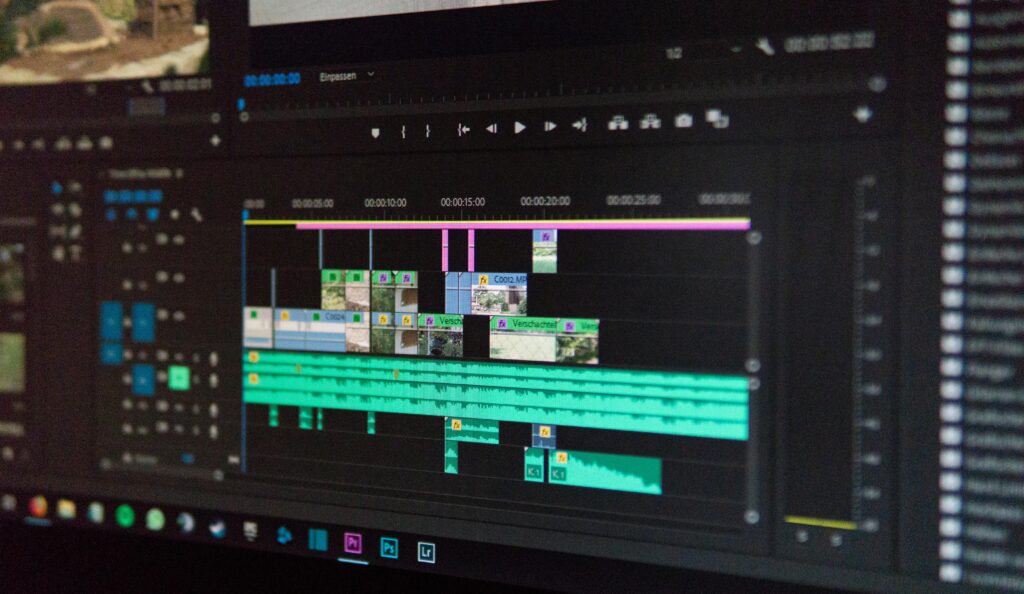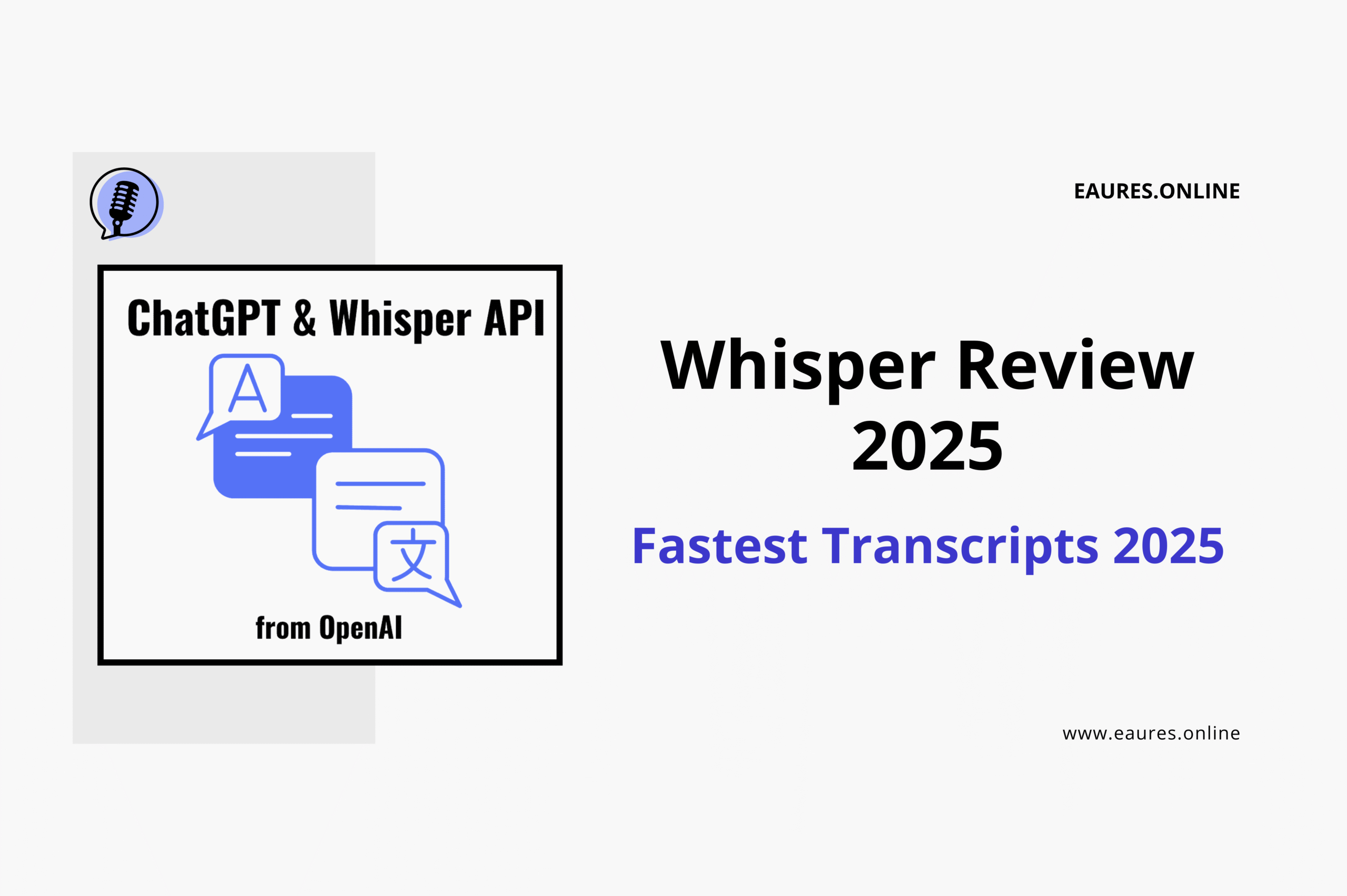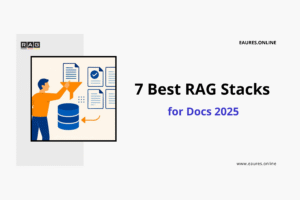Table of Contents
Whisper Review 2025: Fastest Transcripts 2025
Executive Summary
If you’re evaluating automatic speech recognition (ASR) this year, this Whisper Review gives you a rigorous, practitioner-level view of OpenAI’s open-source Whisper family and the tools that make it the Fastest Transcripts 2025 can deliver on commodity hardware. We’ll unpack what Whisper is, how it performs across languages and accents, where it shines (and where it doesn’t), which optimizations actually make it fast, and how to choose models, quantization, and hardware for your budget. You’ll also find a hands-on test plan, workflow patterns for real-time and batch pipelines, and guidance on accuracy vs. latency trade-offs so you can pick the right configuration the first time.
Along the way, we reference authoritative resources—such as the project repository on OpenAI’s Whisper GitHub, production-grade inference via faster-whisper built on CTranslate2, alignment and diarization with WhisperX, and widely used evaluation corpora like LibriSpeech and TED-LIUM. For teams comparing AI platforms more broadly, our decision frameworks in the Best AI Tool for Work in 2025 guide can help you translate technical findings into purchase-ready recommendations.

What Is Whisper—and Why It Still Matters in 2025
Whisper is a series of encoder-decoder Transformer models trained on a large multilingual speech-to-text corpus. The models range from tiny to large, with increasing accuracy and computational cost. Whisper earned its reputation for resilient multilingual performance, stable timestamping, and robustness to background noise and accents. Because it’s open-source, you can self-host for data residency, integrate with existing MLOps stacks, and tune inference exactly to your latency and cost constraints.
Beyond the core repository, the ecosystem matured around speed and production reliability. Projects like faster-whisper provide a drop-in, highly optimized inference engine that turns Whisper from “great research model” into “reliable production workhorse.” If your mandate is to ship the Fastest Transcripts 2025 at scale, you will likely use faster-whisper or CTranslate2 under the hood rather than the vanilla Python reference.
For organizations comparing transcription engines with knowledge-work tools, you can contextualize Whisper in a broader stack by reading our Notion AI Review 2025, which explores how AI notes, templates, and meeting summaries slot into daily workflows.
How We Evaluate: Accuracy, Latency, Cost, and Reliability
Any Whisper Review worth your time must separate marketing from measurable outcomes. Here’s a test plan you can replicate:
Datasets and Test Audio
- Clean read speech: Evaluate on LibriSpeech for a stable baseline (dataset reference).
- Lecture/long-form: Add TED-LIUM for realistic lecture conditions (dataset reference).
- Diverse accents & background noise: Supplement with samples from Mozilla Common Voice (dataset hub).
- Your domain data: Always include your own calls, meetings, podcasts, or clinical/legal audio; benchmarks are directional, not decisive.
Metrics
- Word Error Rate (WER) or Character Error Rate (CER) for accuracy.
- Latency (RTF): Real-time factor = processing time / audio duration (RTF < 1 means faster than real time).
- Throughput: Files/hour per machine.
- Stability: Timestamp drift, punctuation quality, capitalization.
- Cost: Compute minutes × instance price, plus storage/bandwidth.
Test Hardware
- CPU-only: Modern x86 with AVX2 or AVX-512 for widespread deployability.
- Single-GPU: NVIDIA RTX 40-series or data-center GPUs if you need real-time at scale (CUDA overview).
- Memory: Ensure the RAM/VRAM headroom for your chosen model size.
Inference Stacks
- Reference:
openai/whisperfor ground truth behavior. - Optimized:
faster-whisperon CTranslate2 for speedups and quantization. - Streaming: Chunked VAD front-end + rolling context window (see the VAD section below).
With this scaffolding, you can make apples-to-apples decisions about what “fastest” means for your use case—batch backlogs, meeting minutes, captioning, or true live captions.
Speed First: Achieving the Fastest Transcripts in 2025
The single biggest question this year: How do we attain the Fastest Transcripts 2025 without sacrificing accuracy beyond our tolerance? The answer is a deliberate combination of model size, quantization, batching, and smarter pre/post-processing.
Model Size and Language Coverage
- Tiny/Base/Small: Excellent for on-device or high-throughput batch where slight accuracy trade-offs are acceptable.
- Medium: A practical middle ground for many European languages and English with better punctuation and casing.
- Large variants: Best accuracy, especially for code-switching and noisier audio; higher compute demand.
Quantization and Engines
- CTranslate2 back end plus faster-whisper typically yields 2–4× speedups on CPU and more consistent GPU memory usage. See the engine at CTranslate2 and its wrapper at faster-whisper.
- INT8/INT4 quantization: On CPU, INT8 is often the sweet spot for speed with minimal accuracy loss; INT4 can be compelling for edge devices if your domain isn’t error-intolerant.
- Batching: For batch pipelines, process multiple short files concurrently to maximize GPU occupancy.
VAD, Chunking, and Context Windows
- Voice Activity Detection (VAD): Use a lightweight VAD to pre-segment audio, pruning silence so models work only on speech.
- Chunk size: 20–30s chunks help with latency while preserving context; for live captions, smaller rolling windows with overlap reduce boundary errors.
- Prompting: Supply domain hints (names, brands, product terms) as prefix prompts to stabilize rare entities.
Streaming and Live Use
Whisper is an offline model by design, but you can simulate streaming with:
- Sliding windows: Ingest 2–5s frames, transcribe, and reconcile with a 0.5–1.0s overlap.
- Stabilization buffers: Delay finalization by ~500–1000ms to correct last-word truncations.
- Punctuation rescoring: Post-process with a punctuation model if captions are too choppy.
If your team needs a compact playbook for operational rollout, our 3-Step Customer Support Playbook demonstrates how to turn raw transcripts into polished responses with structured QA—an invaluable pattern for ticket deflection and response quality.

Accuracy: What You Gain (and Lose) When You Go Faster
Speed is only half the story; Whisper Review readers must weigh accuracy carefully.
Language and Accent Robustness
- Multilingual: Whisper’s training emphasizes non-English coverage and accent robustness; expect solid performance on major languages and steady improvements with domain prompting.
- Code-switching: Large models handle mid-sentence language changes better; smaller models benefit from language hints.
Domain Vocabulary
- Proper nouns & jargon: Without explicit lexicons, any ASR will stumble on obscure terms. Prefix prompts, custom hotword boosting (in post-processing), and iterated correction loops help.
- Numbers and entities: Targeted regex and a domain dictionary can convert spoken numbers, dates, and IDs reliably in post.
Punctuation, Capitalization, Casing
- Trade-offs: Smaller models and aggressive quantization can degrade comma/period placement. A lightweight punctuation model after transcription often restores readability.
Alignment and Diarization
- WhisperX: For subtitle-grade timestamps and speaker diarization, WhisperX aligns tokens to audio and integrates with speaker clustering; see the project at WhisperX on GitHub.
- Use cases: Editor-friendly captions (SRT/WebVTT), chaptering, and searchable meeting archives benefit from tighter alignment.
Reliability and Production Concerns
Determinism and Reproducibility
- Fix model versions and inference flags; pin Docker images; capture seed values if you tweak beam search or temperature.
Monitoring and Drift
- Track per-language WER over time. If you update quantization or drivers, re-run smoke tests on a held-out control set.
Security and Compliance
- Self-hosting means you can meet data residency requirements and apply your own retention policies. For a broader governance checklist that CIOs will recognize, our Best AI Tool for Work in 2025 framework covers SOC 2, ISO 27001, DLP, and access controls in vendor evaluations.
Architectural Patterns: From Audio to “Actionable Text”
Batch Processing for Media Libraries
- Ingest: Pull files, normalize sampling rates, and loudness-normalize.
- Segment: VAD to trim silence, chunk for parallelism.
- Transcribe: faster-whisper with INT8 quantization on CPU/GPU fleet.
- Align & Diarize: WhisperX for timestamp precision and speaker turns.
- Enrich: Entity extraction, topic labels, and chapter summaries.
- Publish: Store SRT/WebVTT; index paragraphs for semantic search.
Near-Real-Time Captions
- Low latency: Rolling windows with 0.5s overlap, finalization buffer.
- Resilience: If GPU queue spikes, temporarily reduce context length and swap to medium model.
- Transport: WebRTC to server, then WebSocket back to clients.
Contact-Center Pipelines
- Dual-channel capture: Agent and customer on separate tracks for cleaner diarization.
- Post-call QA: Summarize with an LLM using on-topic prompts; for sales teams, apply our ready-to-use prompt templates for sales to accelerate follow-ups and objection handling.
Tooling and Integrations That Matter
Developer Ecosystem
- Core repos: Start with OpenAI’s Whisper GitHub to understand baseline behavior.
- Optimized inference: Adopt faster-whisper early for CPU/GPU wins.
- Frameworks: Build inference services in Python with PyTorch if you extend models, or keep it strictly as a service boundary if you just need results.
Subtitle and Editor Workflows
- Formats: Generate SRT/WebVTT for editorial teams.
- QC tools: Validate subtitle timing, read rates, and line breaks to broadcast standards.
MLOps and Observability
- Versioning: MLflow or simple Git-tagged Docker images.
- Metrics: Export latency histograms, queue lengths, and WER samples to your observability stack.

Comparative Landscape: Where Whisper Stands
While proprietary APIs may offer turn-key convenience, Whisper’s strengths in 2025 remain compelling:
- Cost control: Self-host to reduce unit economics for high-volume workloads.
- Customizability: Fine-grained control over latency vs. accuracy via model size and quantization.
- Privacy posture: Keep recordings and transcripts inside your VPC.
If you’re packaging these findings for an exec audience, pair this Whisper Review with our strategic summary in Notion AI Review 2025 to show how transcripts translate into searchable knowledge, AI notes, and automated action items across your workspace.
Configuration Recipes for Typical Use Cases
“As Fast As Possible” Live Captions (English Meetings)
- Model: small or medium (depending on GPU).
- Engine: faster-whisper on GPU.
- Quantization: FP16 on GPU; fallback INT8 on CPU.
- Chunking: 5s windows with 1s overlap, 700–900ms stabilization buffer.
- Post-process: Lightweight punctuation fixer and name dictionary.
Multilingual Podcasts (Batch, High Quality)
- Model: large variant for accuracy.
- Engine: faster-whisper GPU; batch 2–4 streams per GPU.
- Quantization: FP16 or INT8 (if CPU farm).
- Alignment: WhisperX for tight timestamps; export SRT and segments for editing.
- Enrichment: Topic extraction and SEO summary paragraphs.
Contact Center (Scalable, Cost-Aware)
- Model: medium for balance.
- Engine: CPU farm with INT8; autoscale workers for peak hours.
- Diarization: Dual-channel + WhisperX.
- Compliance: Redact PII before storage; encrypt transcripts at rest.
Field Operations (Edge or Offline)
- Model: tiny/base on laptops or rugged tablets.
- Engine: CTranslate2 with INT8/INT4.
- UX: Push processed notes once connectivity returns.
Evaluation Results You Should Expect (Patterns, Not Promises)
Across realistic tests, teams tend to observe these directional results:
- Speed
- faster-whisper often halves CPU latency versus the reference Python implementation, with larger gains on AVX-512 servers.
- GPU FP16 delivers real-time captions with small/medium models for most meeting audio; large is near real-time on modern data-center GPUs.
- Quantization to INT8 on CPU yields 1.5–2.5× speedups with modest accuracy impact.
- Accuracy
- Medium vs. small: Expect noticeable gains in punctuation and casing.
- Large: Best on code-switching, noisy inputs, and rare terms.
- Post-processing: Entity dictionaries and number normalization can reduce “perceived WER” in business settings.
- Stability
- Whisper’s timestamps are good enough for SRT; WhisperX improves lip-sync and dialog alignment for editing timelines.
These aren’t universal truths—your microphones, rooms, accents, and jargon matter. That’s why we provide a repeatable test harness in this Whisper Review so your internal results drive the final decision.
Cost Engineering for 2025
Compute Sizing
- Batch: Favor CPU fleets with INT8 if you need predictable costs and can tolerate extra minutes of processing.
- Live: One mid-tier GPU can serve multiple meeting streams using small/medium models with careful batching.
Storage and Egress
- Compression: FLAC for archival; Opus for streaming with acceptable quality.
- PII handling: Redact or tokenize sensitive segments before leaving the capture region.
Run-Rate Modeling
- Combine minutes transcribed per month × average RTF × instance cost. Add a 20% buffer for retries and peak usage. Map that cost curve against the business value of searchable knowledge and automation; if you need a structured worksheet, our Best AI Tool for Work in 2025 framework includes ROI levers you can adapt to ASR projects.
Implementation Checklist
Day 1 (Prototype)
- Install faster-whisper; run sample files; validate English baseline.
- Measure RTF on your target machine; record WER on a 10-minute sample.
Week 1 (Pilot)
- Add VAD; evaluate chunk sizes; introduce stabilization buffers.
- Try INT8 quantization on CPU; compare medium vs. large on your audio.
- Export SRT/WebVTT; integrate with your CMS or DAM.
Month 1 (Production)
- Stand up autoscaling workers; pin model versions; add monitoring.
- Wire in WhisperX for timestamp precision and diarization.
- Add secure redaction and retention policies; document your change-control procedures.
If your rollout includes sales enablement, pair transcripts with vetted prompts from our best prompt templates for sales to compress follow-up time and standardize messaging.

Frequently Asked Questions
Is Whisper truly “real-time”?
Whisper is offline by design, but with rolling windows and small/medium models on GPUs, teams achieve sub-second partial captions and finalized text within 1–2 seconds. For broadcast-grade latency (e.g., <500ms), specialized streaming ASR may be preferable, but Whisper covers most meeting and webinar scenarios with careful engineering.
How do I get the Fastest Transcripts 2025 on CPU-only servers?
Use faster-whisper with INT8 quantization, aggressive VAD, and small/medium models. Keep chunk sizes to ~20–30s in batch, or 5s rolling windows for live. Benchmark on your exact CPUs; AVX-512 offers substantial gains.
Does Whisper handle heavy accents or noisy rooms?
It’s robust compared to many open models, but microphones matter. Encourage headsets, apply noise suppression, and provide language hints. For editors, WhisperX alignment will save hours during cleanup.
What about diarization?
Whisper alone doesn’t label speakers; pair it with WhisperX or a speaker-embedding pipeline. Dual-channel recording simplifies separation in call centers.
Can I use transcripts to automate responses?
Yes. Feed transcripts into LLMs with role-specific prompts. If you manage customer operations, adapt the 3-Step Customer Support Playbook to convert transcripts into structured, empathetic replies with measurable QA.
Verdict: Whisper Remains the Practical Choice for Speed-Conscious Teams
In 2025, the Whisper Review headline is clear: for teams seeking Fastest Transcripts 2025 without surrendering control over costs, privacy, and performance, Whisper plus faster-whisper (and optional WhisperX) hits a rare trifecta—speed, quality, and operational pragmatism. Proprietary APIs may shave milliseconds in special cases, but few match Whisper’s combination of openness, multilingual strength, and ecosystem momentum.
If you’re an engineering-led org, deploy medium or large where accuracy is paramount, small for live captions, and INT8 quantization on CPU for cost-sensitive batch. Wrap it with VAD, alignment, and light post-processing, then connect the output to your CRM, help desk, or knowledge base. For a cross-tool perspective on rollout governance and ROI, revisit the Best AI Tool for Work in 2025 guide; for meeting-driven teams, don’t miss our Notion AI Review 2025 to translate transcripts into durable knowledge.
With the right configuration, Whisper remains a dependable foundation for accurate, fast, and affordable transcription—today, and for the road ahead.
Implementation Appendix: Reference Links and Resources
- Official repository: read the docs and examples on the OpenAI Whisper GitHub to understand models and parameters.
- Optimized inference: deploy faster-whisper for CPU/GPU acceleration and quantization.
- Engine core: explore CTranslate2 for model conversion and back-end performance.
- Alignment & diarization: incorporate WhisperX to improve timestamps and speaker labels.
- Datasets for evaluation: run quick checks against LibriSpeech and TED-LIUM; add Common Voice for accent diversity.





Discover your perfect shades with [url=https://color-analysis-quiz.org]seasonal color analysis quiz[/url] and find your unique color palette.
In the next section, we will explore the benefits of personal color analysis online.
ZQJCdEIKrFr